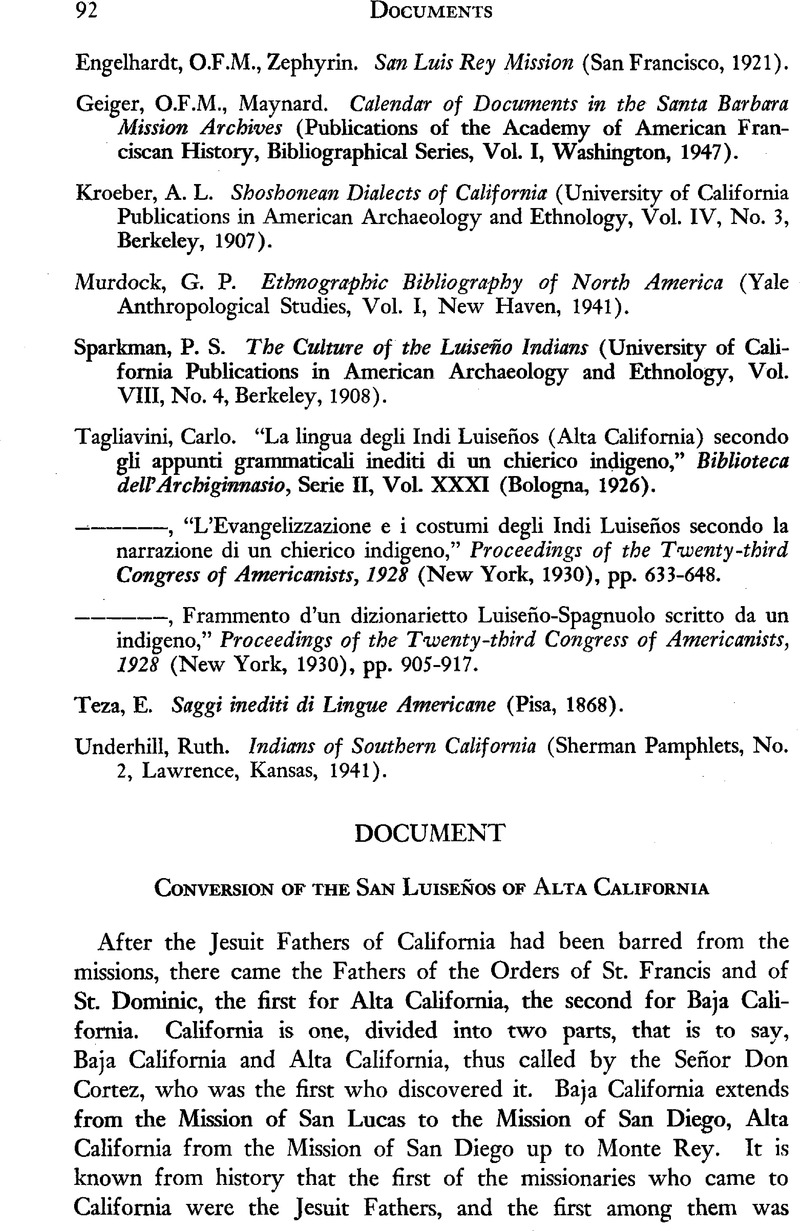No CrossRef data available.
Article contents
Conversion of the San Luiseños of Alta California
Published online by Cambridge University Press: 11 December 2015
Abstract

- Type
- Documents
- Information
- Copyright
- Copyright © Academy of American Franciscan History 1953
References
18 The Jesuit missions did not extend north of the present border of the Mexican State of Baja California. The first missions in what is now the State of California, U. S. A., were established by the Franciscans, beginning with Mission San Diego de Alcalá in 1769. Tac here also reverses and misspells the name of Father Juan Salvatierra, S.J., the famous missionary of Baja California.
19 Another leaf of the Tac MS contains a slightly different version of this passage. Tagliavini, , “ L’Evangelizzazione e i costumi degli Indi Luiseños,” pp. 638–639 Google Scholar, note 24.
20 Sosabitom was the term for Spaniards only. The Anglo-Americans were called momñawechom, from momat (ocean), i. e., “ocean people.” Kroeber, A. E., Shoshonean Dialects of California (Berkeley, 1907), p. 73.Google Scholar
21 Here another leaf of the MS gives a variant version with the following additional information: “Our country, before the Fernandino came, was a woods. He ordered them to cut the trees and make in this fashion a clearing.” Tagliavini, , “L’Evangelizzazione e i costumi degli Indi Luiseños,” p. 639 Google Scholar, note 28.
22 Here the variant reads: “… with altars, one in the middle and the other two on the sides. On the main altar there are statues of many saints, and in the middle, St. Louis, King of France; lower, that of the Virgin Mary, of wood. On the right side of the main altar there is a second altar and the statues which are as follows: the statue of St. Joachim, [and] of [St.] Joseph. The altar placed on the left is of St. Anthony of Padua.”
23 The word “small” (chicas) has been added in the handwriting of Cardinal Mezzofanti. (T)
24 The numbers refer to a plan of Mission San Luis Rey which has been lost. No plan survives from the Spanish or Mexican period. The modern restoration of the Mission buildings has been carried out in view of the changed function of the institution, which is now a Franciscan House of Studies.
25 Referring to the missionary’s quarters, the variant reads: “The house is square, has a large patio—in the middle, a wooden clock—and on the four sides, four bitter orange trees.”
26 Meaning not determined. Perhaps the word should be read as tapanco, a small shed.
27 Pala is a village still inhabited by Luiseño Indians in 1952. The village and the surrounding lands now constitute an Indian Reservation, which is bordered on the east by Mt. Palomar, site of the 200-inch reflecting telescope. In the Spanish period, Pala was a mission-station called San Antonio de Pala.
28 A page is missing here from the MS. (T)
29 Tac here has a drawing of the turnstile gate, which makes the passage much easier to understand. See Plate 4.
30 The “lion” is the mountain lion, or puma (felis concolor).
31 Temeco is probably Temécula, a village about eleven miles northwest of Pala.
32 The variant pages of the MS supply the following additional remark: “… for good harvest.” Since the Luiseños did not practice agriculture before the coming of the missionaries, this may refer to the harvest of wild plant-foods, such as acorns.
33 The variant reads: “The Apaches, another tribe, also have their dance. The Christian Diegueños have their dances. The Sanluiseños, which we are, have many for men, and the women have other kinds. Also the Sanjuaneños, the Gabrielinos, the Fernandinos [i. e., the Fernandeños of Mission San Fernando Rey de España] and those of Monterey—they also have their dances, different one from another.”
34 The variant reads: “One in general—we call it tannis, to dance, or better, to kick.”
35 The variant reads: “In the morning, these dancers get up and the elders give them something to drink, and afterwards it is said that they are dancers, and then they can dance and no one can stop them from dancing.”
36 Here Tac supplies a drawing of the two dancers in costume. See Plate 3.
37 The variant reads: “… leaving the house they cry out, meaning ‘make way!’ carrying their wooden swords which we call uacatom. …”
38 Mission San Juan Capistrano, founded in 1776, northwest of San Luis Rey. The Indians, known to ethnographers as Juaneños, spoke a Shoshonean dialect of Southern California which is closely related to the Luiseño dialect.




